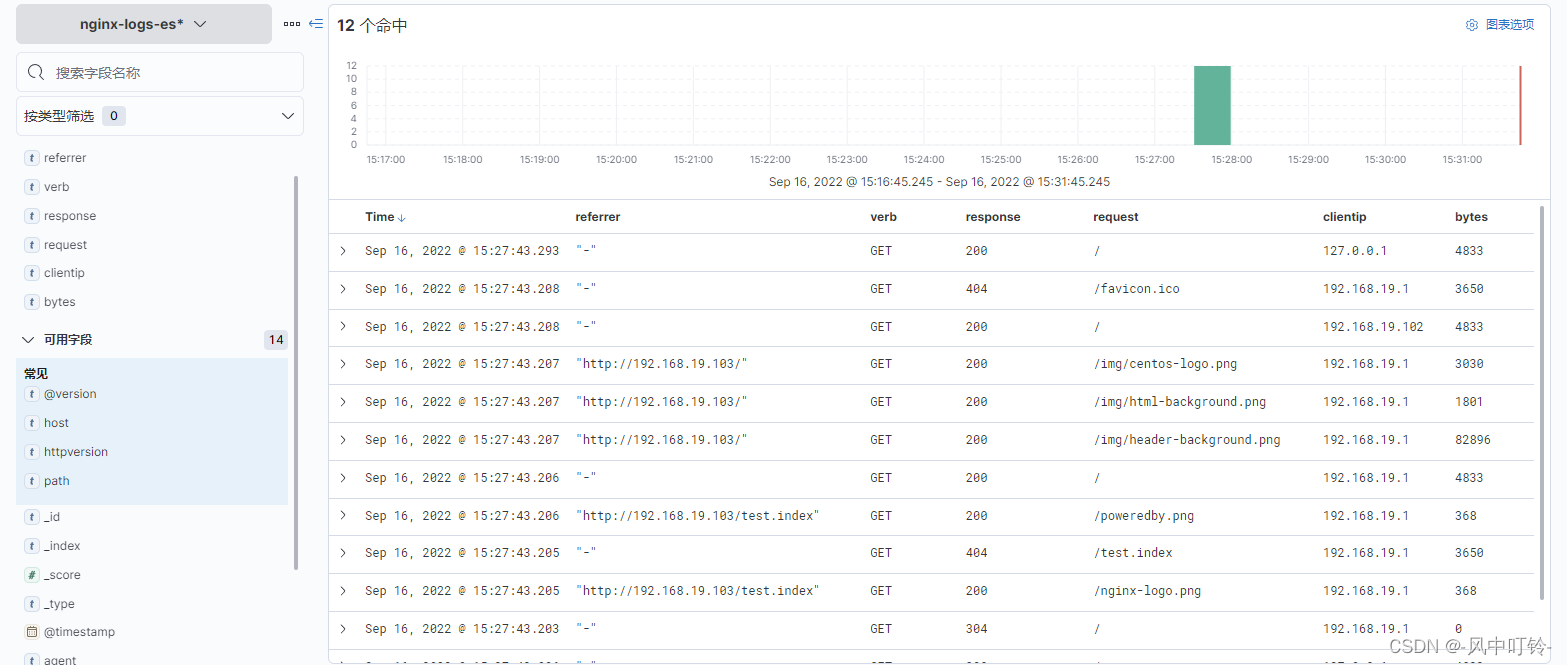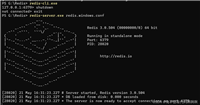第3章 logstash数据分析
logstash使用管道方式进行日志的搜集处理和输出。有点类似*nix系统的管道命令 xxx | ccc | ddd,xxx执行完了会执行ccc,然后执行ddd。
在logstash中,包括了三个阶段:
输入input --> 处理filter(不是必须的) --> 输出output

每个阶段都由很多的插件配合工作,比如file、elasticsearch、redis等等。
每个阶段也可以指定多种方式,比如输出既可以输出到elasticsearch中,也可以指定到stdout在控制台打印。
elfk架构示意图:

1.logstash基础部署
- 安装软件
[root@host3 ~]# yum install logstash --enablerepo=es -y # 偶尔需要使用的仓库可以将它关闭,用到的时候临时打开
[root@host3 ~]# ln -sv /usr/share/logstash/bin/logstash /usr/local/bin/ # 做软连接,命令就可以直接使用了
"/usr/local/bin/logstash" -> "/usr/share/logstash/bin/logstash"
- 创建第一个配置文件
[root@host3 ~]# vim 01-stdin-stdout.conf
input {
stdin {}
}
output {
stdout {}
}
- 测试配置文件
[root@host3 ~]# logstash -tf 01-stdin-stdout.conf
- 自定义启动,这种方式通常用于实验环境,业务环境下,通常将配置修改后,使用systemctl来管理服务
[root@host3 ~]# logstash -f 01-stdin-stdout.conf
using bundled jdk: /usr/share/logstash/jdk
openjdk 64-bit server vm warning: option useconcmarksweepgc was deprecated in version 9.0 and will likely be removed in a future release.
warning: could not find logstash.yml which is typically located in $ls_home/config or /etc/logstash. you can specify the path using --path.settings. continuing using the defaults
could not find log4j2 configuration at path /usr/share/logstash/config/log4j2.properties. using default config which logs errors to the console
[info ] 2022-09-15 21:49:37.109 [main] runner - starting logstash {"logstash.version"=>"7.17.6", "jruby.version"=>"jruby 9.2.20.1 (2.5.8) 2021-11-30 2a2962fbd1 openjdk 64-bit server vm 11.0.16+8 on 11.0.16+8 +indy +jit [linux-x86_64]"}
[info ] 2022-09-15 21:49:37.115 [main] runner - jvm bootstrap flags: [-xms1g, -xmx1g, -xx:+useconcmarksweepgc, -xx:cmsinitiatingoccupancyfraction=75, -xx:+usecmsinitiatingoccupancyonly, -djava.awt.headless=true, -dfile.encoding=utf-8, -djdk.io.file.enableads=true, -djruby.compile.invokedynamic=true, -djruby.jit.threshold=0, -djruby.regexp.interruptible=true, -xx:+heapdumponoutofmemoryerror, -djava.security.egd=file:/dev/urandom, -dlog4j2.isthreadcontextmapinheritable=true]
[info ] 2022-09-15 21:49:37.160 [main] settings - creating directory {:setting=>"path.queue", :path=>"/usr/share/logstash/data/queue"}
[info ] 2022-09-15 21:49:37.174 [main] settings - creating directory {:setting=>"path.dead_letter_queue", :path=>"/usr/share/logstash/data/dead_letter_queue"}
[warn ] 2022-09-15 21:49:37.687 [logstash::runner] multilocal - ignoring the 'pipelines.yml' file because modules or command line options are specified
[info ] 2022-09-15 21:49:38.843 [logstash::runner] reflections - reflections took 114 ms to scan 1 urls, producing 119 keys and 419 values
[warn ] 2022-09-15 21:49:39.658 [logstash::runner] line - relying on default value of `pipeline.ecs_compatibility`, which may change in a future major release of logstash. to avoid unexpected changes when upgrading logstash, please explicitly declare your desired ecs compatibility mode.
[warn ] 2022-09-15 21:49:39.703 [logstash::runner] stdin - relying on default value of `pipeline.ecs_compatibility`, which may change in a future major release of logstash. to avoid unexpected changes when upgrading logstash, please explicitly declare your desired ecs compatibility mode.
configuration ok
[info ] 2022-09-15 21:49:39.917 [logstash::runner] runner - using config.test_and_exit mode. config validation result: ok. exiting logstash
[root@host3 ~]# logstash -f 01-stdin-stdout.conf
using bundled jdk: /usr/share/logstash/jdk
openjdk 64-bit server vm warning: option useconcmarksweepgc was deprecated in version 9.0 and will likely be removed in a future release.
warning: could not find logstash.yml which is typically located in $ls_home/config or /etc/logstash. you can specify the path using --path.settings. continuing using the defaults
could not find log4j2 configuration at path /usr/share/logstash/config/log4j2.properties. using default config which logs errors to the console
[info ] 2022-09-15 21:50:25.095 [main] runner - starting logstash {"logstash.version"=>"7.17.6", "jruby.version"=>"jruby 9.2.20.1 (2.5.8) 2021-11-30 2a2962fbd1 openjdk 64-bit server vm 11.0.16+8 on 11.0.16+8 +indy +jit [linux-x86_64]"}
[info ] 2022-09-15 21:50:25.103 [main] runner - jvm bootstrap flags: [-xms1g, -xmx1g, -xx:+useconcmarksweepgc, -xx:cmsinitiatingoccupancyfraction=75, -xx:+usecmsinitiatingoccupancyonly, -djava.awt.headless=true, -dfile.encoding=utf-8, -djdk.io.file.enableads=true, -djruby.compile.invokedynamic=true, -djruby.jit.threshold=0, -djruby.regexp.interruptible=true, -xx:+heapdumponoutofmemoryerror, -djava.security.egd=file:/dev/urandom, -dlog4j2.isthreadcontextmapinheritable=true]
[warn ] 2022-09-15 21:50:25.523 [logstash::runner] multilocal - ignoring the 'pipelines.yml' file because modules or command line options are specified
[info ] 2022-09-15 21:50:25.555 [logstash::runner] agent - no persistent uuid file found. generating new uuid {:uuid=>"3fc04af1-7665-466e-839f-1eb42348aeb0", :path=>"/usr/share/logstash/data/uuid"}
[info ] 2022-09-15 21:50:27.119 [api webserver] agent - successfully started logstash api endpoint {:port=>9600, :ssl_enabled=>false}
[info ] 2022-09-15 21:50:28.262 [converge pipelineaction::create<main>] reflections - reflections took 110 ms to scan 1 urls, producing 119 keys and 419 values
[warn ] 2022-09-15 21:50:29.084 [converge pipelineaction::create<main>] line - relying on default value of `pipeline.ecs_compatibility`, which may change in a future major release of logstash. to avoid unexpected changes when upgrading logstash, please explicitly declare your desired ecs compatibility mode.
[warn ] 2022-09-15 21:50:29.119 [converge pipelineaction::create<main>] stdin - relying on default value of `pipeline.ecs_compatibility`, which may change in a future major release of logstash. to avoid unexpected changes when upgrading logstash, please explicitly declare your desired ecs compatibility mode.
[info ] 2022-09-15 21:50:29.571 [[main]-pipeline-manager] javapipeline - starting pipeline {:pipeline_id=>"main", "pipeline.workers"=>2, "pipeline.batch.size"=>125, "pipeline.batch.delay"=>50, "pipeline.max_inflight"=>250, "pipeline.sources"=>["/root/01-stdin-stdout.conf"], :thread=>"#<thread:0x32e464e6 run>"}
[info ] 2022-09-15 21:50:30.906 [[main]-pipeline-manager] javapipeline - pipeline java execution initialization time {"seconds"=>1.33}
warning: an illegal reflective access operation has occurred
warning: illegal reflective access by com.jrubystdinchannel.stdinchannellibrary$reader (file:/usr/share/logstash/vendor/bundle/jruby/2.5.0/gems/jruby-stdin-channel-0.2.0-java/lib/jruby_stdin_channel/jruby_stdin_channel.jar) to field java.io.filterinputstream.in
warning: please consider reporting this to the maintainers of com.jrubystdinchannel.stdinchannellibrary$reader
warning: use --illegal-access=warn to enable warnings of further illegal reflective access operations
warning: all illegal access operations will be denied in a future release
[info ] 2022-09-15 21:50:31.128 [[main]-pipeline-manager] javapipeline - pipeline started {"pipeline.id"=>"main"}
the stdin plugin is now waiting for input:
[info ] 2022-09-15 21:50:31.270 [agent thread] agent - pipelines running {:count=>1, :running_pipelines=>[:main], :non_running_pipelines=>[]}
abc
{
"message" => " abc",
"@version" => "1",
"host" => "host3.test.com",
"@timestamp" => 2022-09-15t13:52:02.984z
}
bbb
{
"message" => "bbb",
"@version" => "1",
"host" => "host3.test.com",
"@timestamp" => 2022-09-15t13:52:06.177z
}
2.输入类型
在上例中,输入类型是stdin,也就是手动输入,而在生产环境中,日志不可能通过手工输入的发生产生,因此stdin通常都是用于测试环境是否搭建成功,下面会介绍几种常见的输入类型。
2.1 file
input {
file {
path => ["/tmp/test/*.txt"]
# 从最开始读日志文件(默认是末尾),仅在读取记录没有任何记录的情况下生效,也就是说,在服务停止的时候有新文件产生,服务器启动后可以读取到(旧文件不行)
start_position => "beginning"
}
}
文件的读取记录放在/usr/share/logstash/data/plugins/inputs/file/.sincedb_3cd99a80ca58225ec14dc0ac340abb80中
[root@host3 ~]# cat /usr/share/logstash/data/plugins/inputs/file/.sincedb_3cd99a80ca58225ec14dc0ac340abb80
5874000 0 64768 4 1663254379.147252 /tmp/test/1.txt
2.2 tcp
和filebeat一样,logstash同样支持监听tcp的某一个端口,用来接收日志。可以同时监听多个端口
[root@host3 ~]#vim 03-tcp-stdout.conf
input {
tcp {
port => 9999
}
}
output {
stdout {}
}
[root@host2 ~]# telnet 192.168.19.103 9999
trying 192.168.19.103...
connected to 192.168.19.103.
escape character is '^]'.
123456
test
hello
{
"message" => "123456\r",
"@version" => "1",
"@timestamp" => 2022-09-15t15:30:23.123z,
"host" => "host2",
"port" => 51958
}
{
"message" => "test\r",
"@version" => "1",
"@timestamp" => 2022-09-15t15:30:24.494z,
"host" => "host2",
"port" => 51958
}
{
"message" => "hello\r",
"@version" => "1",
"@timestamp" => 2022-09-15t15:30:26.336z,
"host" => "host2",
"port" => 51958
}
2.3 redis
logstash支持直接从redis数据库中拿数据。支持三种redis数据类型:
- list,表示的redis命令为blpop,代表从redis list的左边获取第一个元素,如无元素则阻塞;
- channel,表示的redis命令为subscribe,代表从redis频道获取最新的数据;
- pattern_channel,表示的redis命令为psubscribe,代表通过pattern正则表达式匹配频道,获取最新的数据。
数据类型之间的区别:
- channel与pattern_channel的区别在于,pattern_channel可以通过正则表达式匹配多个频道,而channel是单一频道;
- list与另外两个channel的区别在于,1个channel的数据会被多个订阅的logstash重复获取,1个list的数据被多个logstash获取时不会重复,会被分摊在各个logstash中。
输入配置如下
input {
redis {
data_type => "list" # 指定数据类型
db => 5 # 指定数据库,默认是0
host => "192.168.19.101" # 指定redis服务器ip,默认是localhost
port => 6379
password => "bruce"
key => "test-list"
}
}
redis中追加数据
[root@host1 ~]# redis-cli -h host1 -a bruce
host1:6379> select 5
ok
host1:6379[5]> lpush test-list bruce
(integer) 1
host1:6379[5]> lrange test-list 0 -1
(empty list or set)
host1:6379[5]> lpush test-list hello
(integer) 1
host1:6379[5]> lrange test-list 0 -1 # 可以看到,logstash获取数据后,会将列表清空
(empty list or set)
host1:6379[5]> lpush test-list '{"requesttime":"[12/sep/2022:23:30:56 +0800]","clientip":"192.168.19.1","threadid":"http-bio-8080-exec-7","protocol":"http/1.1","requestmethod":"get / http/1.1","requeststatus":"404","sendbytes":"-","querystring":"","responsetime":"0ms","partner":"-","agentversion":"mozilla/5.0 (windows nt 10.0; win64; x64) applewebkit/537.36 (khtml, like gecko) chrome/105.0.0.0 safari/537.36"}'
logstash获取数据
{
"message" => "bruce",
"@timestamp" => 2022-09-16t08:17:38.213z,
"@version" => "1",
"tags" => [
[0] "_jsonparsefailure"
]
}
# 非json格式数据会报错,但是能接收
[error] 2022-09-16 16:18:21.688 [[main]<redis] json - json parse error, original data now in message field {:message=>"unrecognized token 'hello': was expecting ('true', 'false' or 'null')\n at [source: (string)\"hello\"; line: 1, column: 11]", :exception=>logstash::json::parsererror, :data=>"hello"}
{
"message" => "hello",
"@timestamp" => 2022-09-16t08:18:21.689z,
"@version" => "1",
"tags" => [
[0] "_jsonparsefailure"
]
}
# json格式的数据过来,logstash可以自动解析
{
"clientip" => "192.168.19.1",
"requesttime" => "[12/sep/2022:23:30:56 +0800]",
"querystring" => "",
"@version" => "1",
"agentversion" => "mozilla/5.0 (windows nt 10.0; win64; x64) applewebkit/537.36 (khtml, like gecko) chrome/105.0.0.0 safari/537.36",
"partner" => "-",
"@timestamp" => 2022-09-16t08:23:10.320z,
"protocol" => "http/1.1",
"requeststatus" => "404",
"threadid" => "http-bio-8080-exec-7",
"requestmethod" => "get / http/1.1",
"sendbytes" => "-",
"responsetime" => "0ms"
}
2.4 beats
在filebeat中已经配置好了将日志输出到logstash,在logstash中,只需要接收数据即可。
filebeat配置
filebeat.inputs:
- type: log
paths: /tmp/1.txt
output.logstash:
hosts: ["192.168.19.103:5044"]
logstash配置
input {
beats {
port => 5044
}
}
host2上在/tmp/1.txt中追加111,logstash的输出
{
"message" => "111",
"tags" => [
[0] "beats_input_codec_plain_applied"
],
"agent" => {
"id" => "76b7876b-051a-4df8-8b13-bd013ac5ec59",
"version" => "7.17.4",
"hostname" => "host2.test.com",
"type" => "filebeat",
"name" => "host2.test.com",
"ephemeral_id" => "437ac89f-7dc3-4898-a457-b2452ac4223b"
},
"input" => {
"type" => "log"
},
"host" => {
"name" => "host2.test.com"
},
"log" => {
"offset" => 0,
"file" => {
"path" => "/tmp/1.txt"
}
},
"@version" => "1",
"ecs" => {
"version" => "1.12.0"
},
"@timestamp" => 2022-09-16t08:53:20.975z
}
3. 输出类型
3.1 redis
redis也可以作为输出类型,配置方式和输入类似
output {
redis {
data_type => "list"
db => 6
host => "192.168.19.101"
port => 6379
password => "bruce"
key => "test-list"
}
}
查看redis数据库
[root@host1 ~]# redis-cli -h host1 -a bruce
host1:6379> select 6
ok
host1:6379[6]> lrange test-list 0 -1
1) "{\"message\":\"1111\",\"@version\":\"1\",\"@timestamp\":\"2022-09-16t09:12:29.890z\",\"host\":\"host3.test.com\"}"
3.2 file
file类型是输出到本地磁盘保存。
output {
file {
path => "/tmp/test-file.log"
}
}
3.3 elasticsearch
output {
elasticsearch {
hosts => ["192.168.19.101:9200","192.168.19.102:9200","192.168.19.103:9200"]
index => "centos-logstash-elasticsearh-%{+yyyy.mm.dd}"
}
}
4. filter
filter是一个可选插件,在接收到日志信息后,可以对日志进行格式化,然后再输出。
4.1 grok
grok可以用来解析任意文本并进行结构化。该工具适合syslog日志、apache和其他网络服务器日志。
①简单示例
input {
file {
path => ["/var/log/nginx/access.log*"]
start_position => "beginning"
}
}
filter {
grok {
match => {
"message" => "%{combinedapachelog}"
# "message" => "%{httpd_commonlog}" # 新版本logstash可能会用这个变量
}
}
}
output {
stdout {}
elasticsearch {
hosts => ["192.168.19.101:9200","192.168.19.102:9200","192.168.19.103:9200"]
index => "nginx-logs-es-%{+yyyy.mm.dd}"
}
}
解析出来的结果:
{
"request" => "/",
"bytes" => "4833",
"@version" => "1",
"auth" => "-",
"agent" => "\"curl/7.29.0\"",
"path" => "/var/log/nginx/access.log-20220913",
"ident" => "-",
"verb" => "get",
"message" => "192.168.19.102 - - [12/sep/2022:21:48:29 +0800] \"get / http/1.1\" 200 4833 \"-\" \"curl/7.29.0\" \"-\"",
"httpversion" => "1.1",
"host" => "host3.test.com",
"@timestamp" => 2022-09-16t14:27:43.208z,
"response" => "200",
"timestamp" => "12/sep/2022:21:48:29 +0800",
"referrer" => "\"-\"",
"clientip" => "192.168.19.102"
}

②预定义字段
grok是基于正则表达式来进行匹配,它的语法格式是%{syntax:semantic}
- syntax是将匹配您的文本的模式的名称,这是内置好的语法,官方支持120种字段。
- semantic是您为要匹配的文本提供的标识符,也就是你要给它去的名字。
示例:
- 日志源文件
55.3.244.1 get /index.html 15824 0.043
- 匹配的字段应该是
%{ip:client} %{word:method} %{uripathparam:request} %{number:bytes} %{number:duration}
- 配置文件
input {
stdin {}
}
filter {
grok {
match => { "message" => "%{ip:client} %{word:method} %{uripathparam:request} %{number:bytes} %{number:duration}" }
}
}
output {
stdout {}
}
- 匹配出来的结果
55.3.244.1 get /index.html 15824 0.043
{
"message" => "55.3.244.1 get /index.html 15824 0.043",
"@version" => "1",
"@timestamp" => 2022-09-16t14:46:46.426z,
"method" => "get",
"request" => "/index.html",
"bytes" => "15824",
"duration" => "0.043",
"host" => "host3.test.com",
"client" => "55.3.244.1"
}
针对不同服务的日志,可以查看官方文档的定义:
https://github.com/logstash-plugins/logstash-patterns-core/tree/master/patterns
③自定义字段
当预定义的字段不符合要求时,grok也支持自定义正则表达式来匹配日志信息
- 首先需要创建自定义表达式保存的目录,并将表达式写进去
[root@host3 ~]# mkdir patterns
[root@host3 ~]# echo "postfix_queueid [0-9a-f]{10,11}" >> ./patterns/1
- 修改配置文件
input {
stdin {}
}
filter {
grok {
patterns_dir => ["/root/patterns"] # 指定表达式位置
match => { "message" => "%{syslogbase} %{postfix_queueid:queue_id}: %{greedydata:syslog_message}" } # 这里有系统预定义的,也有自定义的表达式,大括号外的字符就是常规的字符,需要逐个匹配,如冒号:
}
}
output {
stdout {}
}
- 运行并测试
...
the stdin plugin is now waiting for input:
[info ] 2022-09-16 23:22:04.511 [agent thread] agent - pipelines running {:count=>1, :running_pipelines=>[:main], :non_running_pipelines=>[]}
jan 1 06:25:43 mailserver14 postfix/cleanup[21403]: bef25a72965: message-id=<20130101142543.5828399ccaf@mailserver14.example.com>
{
"message" => "jan 1 06:25:43 mailserver14 postfix/cleanup[21403]: bef25a72965: message-id=<20130101142543.5828399ccaf@mailserver14.example.com>",
"host" => "host3.test.com",
"timestamp" => "jan 1 06:25:43",
"queue_id" => "bef25a72965", # 自定义表达式匹配的字段
"logsource" => "mailserver14",
"@timestamp" => 2022-09-16t15:22:19.516z,
"program" => "postfix/cleanup",
"pid" => "21403",
"@version" => "1",
"syslog_message" => "message-id=<20130101142543.5828399ccaf@mailserver14.example.com>"
}
4.2 通用字段
顾名思义,这些字段可以用在所有属于filter的插件中。
- remove_field
filter {
grok {
remove_field => ["@version","tag","agent"]
}
}
- add_field
filter {
grok {
add_field => ["new_tag" => "hello world %{yyyy.mm.dd}"]
}
}
4.3 date
在数据中,会有两个时间戳timestamp和@timestamp,日志产生的时间和数据采集的时间,这两个时间可能会不一致。
date插件可以用来转换日志记录中的时间字符串,参考@timestamp字段里的时间。date插件支持五种时间格式:
- iso8601
- unix
- unix_ms
- tai64n
input {
file {
path => "/var/log/nginx/access.log*"
start_position => "beginning"
}
}
filter {
grok {
match => { "message" => "%{httpd_commonlog}" }
remove_field => ["message","ident","auth","@version","path"]
}
date {
match => [ "timestamp","dd/mmm/yyyy:hh:mm:ss z" ]
# timestamp必须是现有的字段,这里只是对这个字段的时间进行校正,且需要和timestamp字段的原数据格式一致,否则会报解析错误
# timestamp原来的数据格式为"17/sep/2022:18:42:26 +0800",因此时区改成zzz就会一直报错,因为zzz代表asia/shanghai这种格式,z代表+0800
timezone => "asia/shanghai"
}
}
output {
stdout {}
}
输出的格式:
{
"timestamp" => "17/sep/2022:18:42:26 +0800", #和@timestamp有8小时的时间差,可到elasticsearch中查看,如果也有时间差,可以在date中修改timezone
"response" => "200",
"httpversion" => "1.1",
"clientip" => "192.168.19.102",
"verb" => "get",
"host" => "host3.test.com",
"request" => "/",
"@timestamp" => 2022-09-17t10:42:26.000z,
"bytes" => "4833"
}
使用target将匹配到的时间字段解析后存储到目标字段,若不指定,默认是@timestamp字段。这个字段在kibana中创建索引时可以用到
date {
match => [ "timestamp","dd/mmm/yyyy:hh:mm:ss z" ]
timezone => "asia/shanghai"
target => "logtime"
}
# 结果
{
"timestamp" => "17/sep/2022:21:15:30 +0800",
"response" => "200",
"logtime" => 2022-09-17t13:15:30.000z, # 日志产生的时间
"httpversion" => "1.1",
"clientip" => "192.168.19.102",
"verb" => "get",
"host" => "host3.test.com",
"request" => "/",
"@timestamp" => 2022-09-17t13:15:31.357z, # 日志记录的时间,可以看到和日志产生的时间有一定的延迟
"bytes" => "4833"
}
4.4 geoip
用来解析访问ip的位置信息。这个插件是依赖geolite2城市数据库,信息不一定准确,也可以自己下载maxmind格式的数据库然后应用,官方网站有自定义数据库的指导手册。
input {
file {
path => "/var/log/nginx/access.log*"
start_position => "beginning"
}
}
filter {
grok {
match => { "message" => "%{httpd_commonlog}" }
remove_field => ["message","ident","auth","@version","path"]
}
geoip {
source => "clientip" # ip地址的源参考clientip字段
# fields => ["country_name" ,"timezone", "city_name"] # 可以选择显示的字段
}
}
output {
stdout {}
}
得到的结果,可以看到,私有地址无法正常解析
{
"timestamp" => "17/sep/2022:21:15:30 +0800",
"response" => "200",
"geoip" => {},
"httpversion" => "1.1",
"clientip" => "192.168.19.102",
"verb" => "get",
"host" => "host3.test.com",
"tags" => [
[0] "_geoip_lookup_failure" # 私网地址
],
"request" => "/",
"@timestamp" => 2022-09-17t13:30:05.178z,
"bytes" => "4833"
}
{
"timestamp" => "17/sep/2022:21:15:30 +0800",
"response" => "200",
"geoip" => { # 解析的结果放在geoip中
"country_code2" => "cm",
"country_code3" => "cm",
"country_name" => "cameroon",
"ip" => "154.72.162.134",
"timezone" => "africa/douala",
"location" => {
"lon" => 12.5,
"lat" => 6.0
},
"continent_code" => "af",
"latitude" => 6.0,
"longitude" => 12.5
},
"httpversion" => "1.1",
"clientip" => "154.72.162.134",
"verb" => "get",
"host" => "host3.test.com",
"request" => "/",
"@timestamp" => 2022-09-17t13:30:05.178z,
"bytes" => "4833"
}
4.5 useragent
用来解析浏览器的信息。前提是输出的信息有浏览器信息字段。
input {
file {
path => "/var/log/nginx/access.log*"
start_position => "beginning"
}
}
filter {
grok {
match => { "message" => "%{httpd_combinedlog}" } # httpd_combinedlog可以解析浏览器
remove_field => ["message","ident","auth","@version","path"]
}
useragent {
source => "agent" # 指定浏览器信息在哪个字段中,这个字段必须要存在
target => "agent_test" # 为了方便查看,将所有解析后的信息放到这个字段里面去
}
}
output {
stdout {}
}
得到的结果:
{
"timestamp" => "17/sep/2022:23:42:31 +0800",
"response" => "404",
"geoip" => {},
"httpversion" => "1.1",
"clientip" => "192.168.19.103",
"verb" => "get",
"agent" => "\"mozilla/5.0 (x11; linux x86_64; rv:60.0) gecko/20100101 firefox/60.0\"",
"host" => "host3.test.com",
"request" => "/favicon.ico",
"referrer" => "\"-\"",
"@timestamp" => 2022-09-17t15:42:31.927z,
"bytes" => "3650",
"agent_test" => {
"major" => "60",
"name" => "firefox",
"os" => "linux",
"os_full" => "linux",
"os_name" => "linux",
"version" => "60.0",
"minor" => "0",
"device" => "other"
}
}
{
{
...
"agent_test" => {
"major" => "60",
"name" => "firefox",
"os" => "linux",
"os_full" => "linux",
"os_name" => "linux",
"version" => "60.0",
"minor" => "0",
"device" => "other"
}
}
{
...
"agent_test" => {
"os_minor" => "0",
"os_full" => "ios 16.0",
"version" => "16.0",
"os_major" => "16",
"device" => "iphone",
"major" => "16",
"name" => "mobile safari",
"os" => "ios",
"os_version" => "16.0",
"os_name" => "ios",
"minor" => "0"
}
}
{
...
"agent_test" => {
"patch" => "3987",
"os_full" => "android 10",
"version" => "80.0.3987.162",
"os_major" => "10",
"device" => "samsung sm-g981b",
"major" => "80",
"name" => "chrome mobile",
"os" => "android",
"os_version" => "10",
"os_name" => "android",
"minor" => "0"
}
}
4.6 mutate
- 切割自定的字段
input {
stdin {}
}
filter {
mutate {
split => {
message => " " # 将message消息以空格作为分隔符进行分割
}
remove_field => ["@version","host"]
add_field => {
"tag" => "this a test field from bruce"
}
}
}
output {
stdout {}
}
111 222 333
{
"tag" => "this a test field from bruce",
"message" => [
[0] "111",
[1] "222",
[2] "333"
],
"@timestamp" => 2022-09-18t08:07:36.373z
}
- 将切割后的数据取出来
input {
stdin {}
}
filter {
mutate {
split => {
message => " " # 将message消息以空格作为分隔符进行分割
}
remove_field => ["@version","host"]
add_field => {
"tag" => "this a test field from bruce"
}
}
mutate {
add_field => {
"name" => "%{[message][0]}"
"age" => "%{[message][1]}"
"sex" => "%{[message][2]}"
}
}
}
output {
stdout {}
}
bruce 37 male
{
"message" => [
[0] "bruce",
[1] "37",
[2] "male"
],
"age" => "37",
"@timestamp" => 2022-09-18t08:14:31.230z,
"sex" => "male",
"tag" => "this a test field from bruce",
"name" => "bruce"
}
- convert:将字段的值转换成不同的类型,例如将字符串转换成证书,如字段值是一个数组,所有成员都会被转换。如果该字段是散列,则不会采取任何动作
filter {
mutate {
convert => {
"age" => "integer" # 将age转换成数字类型
}
}
}
bruce 20 male
{
"message" => [
[0] "bruce",
[1] "20",
[2] "male"
],
"sex" => "male",
"name" => "bruce",
"age" => 20, # 没有引号,代表已经修改成数字类型了
"@timestamp" => 2022-09-18t08:51:07.633z,
"tag" => "this a test field from bruce"
}
- strip:剔除字段中的前导和尾随的空格
filter {
mutate {
strip => { "name","sex" }
}
}
- rename:修改字段名
filter {
mutate {
rename => { "sex" => "agenda" }
}
}
- replace:替换字段内容
filter {
mutate {
replace => { "tag" => "this is test message" } # 修改了tag字段的内容
}
}
-
update:用法和replace一样,区别在于如果字段存在则修改内容,如果过不存在则忽略此操作
-
uppercase/lowercase:转换成大写/小写;capitalize:首字母大写。转换的是字段内容
filter {
mutate {
uppercase => "tag"
capitalize => "name"
}
}
5 高级特性
5.1 判断语法
在input中打上标记后,可以在output和filter中通过判断语句来做区别化的处理
input {
beats {
port => 8888
type => "nginx-beats"
}
tcp {
port => 9999
type => "tomcat-tcp"
}
}
output {
if [type] == "nginx-beats" {
elasticsearch {
hosts => ["192.168.19.101:9200","192.168.19.102:9200","192.168.19.103:9200"]
index => "nginx-beats-elasticsearh-%{+yyyy.mm.dd}"
}
} else {
elasticsearch {
hosts => ["192.168.19.101:9200","192.168.19.102:9200","192.168.19.103:9200"]
index => "tomcat-tcp-elasticsearh-%{+yyyy.mm.dd}"
}
}
5.2 多实例运行
logstash支持多实例运行,但是如果直接启动,第二个实例会报错,需要指定path.data的路径才能正常启动。
[root@host3 ~]# logstash -f 01-stdin-stdout.conf --path.data /tmp/logstash



发表评论